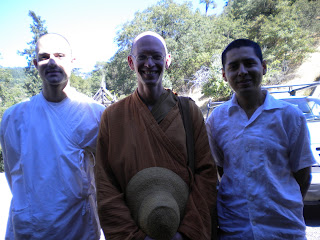Why Would a Lawyer in Training Want to Spend Time with Buddhist Monks?
I first visited Abhayagiri in the Summer of 2011. I was in my second year of law school and was desperately seeking some way to reduce the suffering I was feeling from being in such an unfulfilled and unhappy environment as law school. I decided that I had tried hard enough finding enjoyment in my career, and that it was time to start thinking seriously about looking about joining a spiritual community. I had enjoyed being a part of Common Ground Meditation Center in Minneapolis and doing residential retreats and visiting monasteries. So I thought how much cooler would it be to actually live at a monastery as a monk.
Carving of Ajahn Chah on the Abhayagiri Loop Trail
So I decided to book a two week stay. I did not come with many expectations, and had a great time. So I thought that going back and celebrating having graduated from law school would be even better. I apparently didn't realize that this expectation would cause a lot of suffering later.
The Start of my Two Month Stay
When I arrived at Abayagiri the second time I was tired. I had already finished law school two months before, but I still felt heavy because I did not really have any long term career options that I was pursuing. Even though I did this intentionally, it put me in a position that I was very unfamiliar with: for once in my life I didn't have a clear plan for the future. However, I thought what better place to live in the present moment than at a Buddhist Monastery?
There was just one problem though. This time instead of coming to Abhayagiri with no expectations, I unknowingly expected it to be as I had remembered it. I forgot the eternal rule of life: all things are impermanent.
Although I saw some familiar faces the two people I grew closest two during my stay were back at their own homes living their lives. I did not think too much of this at first, because I was just trying to get oriented to my new surroundings. But it was hard, it took my a while to get used to the people there. Not because the people weren't cool, it was because they weren't what I had expected.
My Home Away from Home
I was happy to be there. But I soon faced one of the first noble truths pretty quickly, the third morning I woke up sick. I felt so weak and had diarrhea. I had no idea what could have happened. One of the monks suggested that I probably was weakened from all the driving I did to make it up there. Whatever it was, it went away pretty quickly. But I next had to deal with other kinds of inconveniences.
Ethereal Mountain Cloud Forest
Accommodations
I loved the little hut I lived in, the dimensions were small, probably 8 feet long seven feet wide with a peaked ceiling probably fourteen feet high from the top. It had everything I needed, it kept the heat out during the day and kept the drafts out during the night. Protected me from insects, and from the wild animals that roam around the forest (foxes, mountain lions, and bears!). It was a secluded spot, very quietly. The only downside was that it didn't have a toilet nearby, or a water spigot. I had to walk 5 minutes to use the facilities in the main cloister area.
The Main Facilities (Cloister)
It was also the only hut in that area of the property, which was pretty scary at times knowing during the pitch black nights when the moon had yet to rise that the nearest person was a 15 minute hike away from you.
I have to admit to being scared every night and every morning I was there for those two months.
Full Moon
However, I managed to stir up the courage to face the darkness each morning. I had purchased a pretty good lantern before I got there, so that provided me some solace.
Things that Bugged Me
What was harder to get over were the insects. They did not bother me too much at first, but then we started clearing out an area of the property where new huts were being built. Its easy to forget how much the forest belongs to the other creatures just as much as it does to you. When we cleared out these areas it seemed like everyday someone was getting serious insect attacks, bees, fleas and mosquitoes were common. It was fine at first, but having to be in that environment day after day started to take its toll on me. I had nothing in the world to worry about, so my mind started to focus on the insects. I would get so annoyed at times. I never killed any, but I did suffer a lot. However, I soon forgot about the insects when people started coming down with posion oak.
Getting Poaked
The undeveloped portions of the monastery are covered with poison oak. I had never before had exposure to it. In fact it seemed like I was immune to it at first. But soon after I started working in the undeveloped area, I became increasingly sensitive to it. It seems like everyday I'd come down with some kind of rash, even after I used poison oak soap. Its silly to think about now, but I was so angry at that. I thought, boy I came here to relax and try to repair the damage to my face caused by those years of stress in law school. Now my face is going to be scarred by mosquito bites and posion oak rashes!
A Rare Non-Poison Oak Meadow
Meditation
At this point you must be wondering, well what about the meditation Isn't that why people go there? Yes, I was getting some serious meditating done, anywhere from two to eight or more hours of formal sitting or walking practice per day. By the end of the second week there I was experiencing very blissful states, where I could just walk and feel like I were walking on clouds. But as soon as I encountered anyone, it would pop my bubble. I'd pick up the idea of my self, I'd become self conscious, and get entangled as the Buddha says, in the web of self identity views.
So I did enjoy my meditation immensely but that was not the main reason I went. I came to Abhayagiri because I wanted to be a part of a community. I wanted to put aside my pettiness, my concern for myself, and learn to be a part of a bigger thing. That definitely happened at time, but I realize now that my individuality has been so conditioned in me to be seen as fundamental that even I felt somewhat stifled at Abhayagiri with its rituals and rules of decorum. I did not let this get me down though, I spent every day meditating or studying.
My Meditation and Yoga Spot
What Did I Learn?
The quality of my meditation definitely waxed and waned. Some days it seemed like I was close to enlightenment; about to break through the wall of the mundane and realize the supreme goal. Other moments I struggled with restlessness, desire, anger, craving, annoyance, bitterness, self rebuke, fear, and all the dark emotions that we like to run away from in everyday life. So I can not say there was an individual moment where I broke through, had an earth shattering insight into the nature of reality.
What I did gain was a deeper familiarity with the patterns of my mind. I saw what tactics my mind thinks up to distract myself from unsatisfactoriness, or even recognizing that I was feeling unsatisfied. I saw how much peace is possible without getting wrapped up in self identity views, and I learned how to not pick it up when its not helpful.
Will I Become a Monk?
I would like to ordain at some point in my life. Unfortunately the conditions are not right for me to do so. Although I can see myself ordaining somewhere when I am 35, when I do it, it will be temporarily. I just don't think I can life the rugged life of a forest monk for long. Similarly living a life as a monk in a city does not appeal to me very much either because it seems so undisciplined, I might as well stick to being a lawyer. It seems like being a lay person is the best choice for me. I think I made the right decision to go to law school after all: probably the biggest shock to me of all.
My Monk Friends
Summary
The highlights of Abhayagiri:
- Learning from some of the most experienced and dedicated Western Buddhist masters in the world
- Meditation for hours on end!!!
- Doing work with your hands
- Feeling a part of a community that shares your values
- Meeting cool new people
- Learning about a different culture
- Eating of the best food in the world
- Accommodations are comfortable
- Everything is offered freely
A Fox on the Trail
The downsides:
- No ingesting anything thicker than strained juice in afternoon. This is a training rule to promote wakefulness, reduce desire for mindless pleasure seeking in food, and ease the burden on the community that supports the meditators.
- Hard to get to, remote location.
- Lifestyle hiking, working, sitting for long is hard on the knees. My knees are still recovering and a lot of the monks have chronic knee problems. Nevertheless, you are encouraged to use a chair if sitting on the ground is uncomfortable.
- Hugs between men or touching people of the opposite sex seems to be unofficially discouraged. Although no one will tell you not to, only the monks do not hug women.
- Gender relations come from a different culture, which seem can sometimes seem backwards. To Abhayagiri's defense, they respect nuns and women mediators, and go out of their way to accommodate women who are allowed to stay there.
- Lots of biting bugs and poison oak. There are far worse annoyances in regular life though.
- Daily schedule is difficult for disabled, ill, or elderly people to keep up with.
Redwood Valley
All things considered spending two months there was a tremendous benefit to me. Yes there are downsides, but the attitude at the monastery is that the hardships help you to train your mind. Restraint may not always be the most joyful way to practice, but it leads to a long term strengthening of the mind, mental discipline, and morality.
I can say now with confidence that I would not rather be anywhere else in life than where I am now. I feel confident with my decision to go to law school, confident with my decision to skip the first bar and try to live like a monk and confident about picking my career back up again.
Back to City Life

















